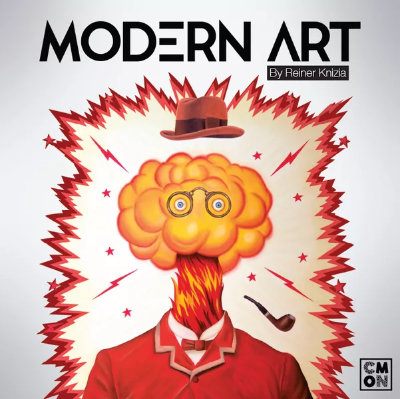Modern Art Board Game Review

By MARK WILSON

Year Published: 1992
Players: 3-5
Playing Time: 45 Minutes
Designer Reiner Knizia toyed with auctions for long stretches of his prolific career. Modern Art is part of a so-called “Auction Trilogy” from Knizia that came out in the 90s, with Ra and Medici rounding out the trio.
But even this is a misnomer, as they were not the only three auction games he designed even in the 90s, let alone the rest of his career.
You would think that there are only so many ways to change the details on auctions games, particularly ones without many additional rules or rules systems. If you did, though, you would be wrong.
However, the central idea behind the auction is that the players get to determine the value of something. Sure, there are limitations and restrictions depending on the game, but these are games about valuation. And ideally, about shifting valuations. What is valuable to me might be worthless to you. Or valuable early may be worthless late, and somewhere in the middle at other points. Or maybe we both want The Thing, but if we price ourselves too high, we’ll lose the benefit. And if others know that, they’ll try to make us pay as much as possible for those benefits. And so on.
That makes them extremely player-driven games. Therein lies both the strengths and/or weaknesses of Modern Art, variable based on what you think of player-driven games in general.
Modern Art – The Premise
You each play as the curator of a fancy museum, and you want the most valuable art collections in your exhibits.
To do this, a rotating auctioneer will put a painting up for sale, by one of five artists. The value of these paintings will shift in each of the game’s rounds, depending on how many of an artist’s paintings have sold that round.
Artist A might be in vogue right now, while Artist D is still waiting for their big break. If a particular artist is huge in multiple rounds, their worth grows commensurately, so that the 30 thousand value painting in round 1 might be worth 70 by round 4.
The other rub is that unless you’re the one doing the auctioning this turn, you’re paying the auctioneer the money you’ve bid on the painting, which equates to victory point (money) for them. It’s an amusing juxtaposition that buying or selling for the best value is how you win the game. It’s not only about acquisition.
The game features a handful of auction types to include some variance. One painting may be a free-for-all that is only determined when the auctioneer closes the bidding. Another might be once around the table, with the auctioneer having the last chance to outbid everyone else. And so on with a few other permutations. It’s also possible for two paintings to be auctioned at once, which can up the stakes dramatically in terms of affecting an artist’s worth and what the prospective payout will be.
Satire in Theme and Gameplay
Satire is tough to do in tabletop gaming. If you’re too on the nose, it comes across as obvious and heavy-handed. We play games for fun, not social commentary…right?
On the other hand, if you’re too sneaky about your satire, you risk no one understanding the statement you’re making.
Modern Art is a parody of the art scene, which is notoriously preoccupied with appearances and trends. Curators will artificially pump up the status of their artists to inflate their own status and worth. If some accounts are to be believed, art sales are a lucrative way of hiding money laundering. In all, it’s not nearly as respectable as it all appears to be, and certainly not as glamorous.
The joke is that none of these paintings are worth anything until we decide they are. The game asks you to take part in this farce with a smile and a wink, though. It’s perfect, arbitrary game theory stuff; the joke is on those who are taking part in similar actions but without that same self-awareness that it’s all just an elaborate game.
The only sad part of the joke is that this parody is subtle, so it’s easy to mistake the seemingly high-stakes bids as an homage to the modern art scene rather than a playful finger wag. As such, not all of the game’s editions bring this reality to life with the same force.
Fortunately, it’s still a lot of fun either way.
The Blessings and Curses of Player-Driven Games
The critique here is that one really irrational actor can ruin the game.
And it’s true. At least, sort of.
If one player severely overvalues a couple paintings and the cost goes to one particular auctioneer, they’re going to be squarely in the lead.
This is not a fault of the game as I see it, but I’m also not going to deny that it exists.
First, the fact that everyone can see these bad deals taking place means that table talk can, and should, be happening so that everyone has a general sense of who they need to catch in value. This can – and probably also should – result in minor collusion between some players to self-balance the game when this happens. And that same supposedly leading player should be doing their best to convince everyone that, ok, you did your job, I’m back in the middle of the pack. Now let’s talk about this lovely painting over here…
This social atmosphere is what defines the game at its best points. Because the truth of the matter is that to win, you’ll have to angle yourself into position to be the recipient of at least a couple dubious purchases, either where you get a valuable painting for too little, or someone else pays you too much. The trick is the manipulation of not just the painting market itself, but the perception of both the market and the fortunes of the table as a whole.
This will turn some off from the experience, certainly. But it also makes Modern Art the most singular game of its type among Knizia’s well-known auctions. The excellent Ra is as much a push-your-luck, set collection game as an auction game. No sin, but is slightly more mechanical as an experience. Medici (also a good game) allows for a lot of Modern Art’s brinkmanship, but its auction structure is always the same. It flows the same throughout, whereas Modern Art jumps in more dramatic fits and starts depending on what’s up for bid and in what auction format.
Modern Art – Conclusions
Modern Art is closer to a social party game for me than those listed above, which are a bit more doggedly strategic. That’s probably why I like it the best of those three, as well as better than nearly any auction game I can name.
The better editions of the game also come with lovely art and – in my particular copy – a weighty wooden gavel. I wouldn’t normally care, but this is the rare exception where grasping and banging the gavel as you auction off a painting comes with true narrative weight in the game. In more animated groups, this even becomes an opportunity for some light roleplaying. You’re play-acting the farce and having a lovely time of it, even as that damn New York City gallery fleeced Paris for far too much money for that last work of art.
At its best, it’s a fluid, open, social system for play that contains mercifully few rules but plenty of variance of both the mechanical, strategic and especially interpersonal variety.
…
Like my content and want more? Check out my other reviews and game musings!
Read More From Bumbling Through Dungeons
Recent Posts
Categories
- All (350)
- Announcements (4)
- Board Games (203)
- DMing (28)
- Game Design (16)
- Playing TTRPGs (22)
- Reviews (189)
- RPGs (142)
- Session Reports (91)
- Why Games Matter (9)